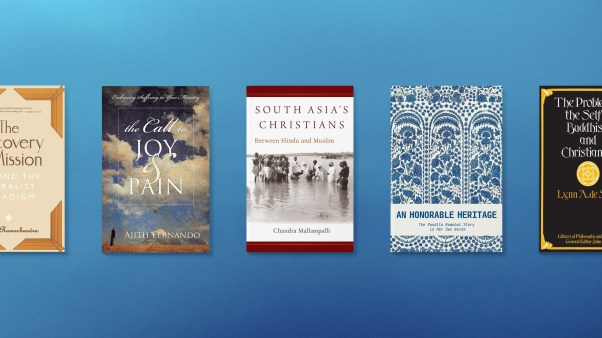Born in Shiprock, New Mexico, he hesitates when asked to pronounce the name of his Navajo clan aloud, though he has known it since his youth. The problem for artist Elmer Yazzie is not secrecy, but that the language of the Dinee—the name by which the Navajos prefer to be known—is not a written one. Attempting to spell the long clause that means “Where the Two Waters Meet” is virtually impossible.
A reservation-born Native American with a mission-school education and a Dutch-American wife, Yazzie is truly an individual at the place where many different waters, or cultures, meet. A lifelong Christian in the Reformed tradition, he received his undergraduate degree in art education at Calvin College in Michigan. He accepted in a general way the Calvinist doctrine of being chosen, but until eight years ago, he had not applied it to his artistic bent.
The artist as spiritual healer
Though he has painted dozens of murals in southwestern churches since 1976 and mentored aspiring artists of all ages for 22 years at the Rehoboth Christian Reformed School, Yazzie’s reluctance to call himself an artist was due, in part, to his Navajo perceptions.
“In the Navajo way of thinking, there is no word that defines artist,” the 44-year-old says in a soft voice. “What the artist is or does has to do with spiritual work,” Yazzie says. “Artists are more like healers—our work can be therapy for ourselves and for others. Sometimes in my own work, I have created works that influenced my life and thinking; later on, someone has come along with a very similar need.”
The concept of art so thoroughly permeates the culture of the Dinee (which means “The People”) that the thought of separating it from life or spirituality strikes Yazzie as absurd. He will tell you that by his personal definition, art is simply “the way to live”—an all-encompassing matter of making choices that, in his case, must please God.
The painting that preached
Yazzie says that for most of his career, he didn’t understand what an artist was. “I had the skill, and I had the understanding, but I didn’t have a real experience with the inspiration,” he says. “I think that’s the critical part. I didn’t totally understand what it meant to be ‘chosen.’ “
But in 1981, when he decided to donate a sabbatical year to a mural painting for a church in Red Mesa, New Mexico, Yazzie experienced inspiration for the first time. The other five Yazzies, including his wife, Sharon, agreed to live off savings for a year. “You were doing it for the love of the whole project, and you knew Who it was for.” Although he is certain that native people, “Christian or not, have a spiritual outlook on life that can outmeasure Christian American people,” he found that many of the church people were biblically illiterate. It took three years to complete the Red Mesa murals—which could cover all the sides of a large bus from floor to rooftop—because Yazzie kept stopping to explain his visual themes to anyone who asked.
One day at Red Mesa, Pastor Jim Charlie was delayed, and Yazzie was asked to preach—extemporaneously. He decided to talk about the mural in progress. He explained his depictions of Abraham, Isaac, and Jacob, and the section where Moses leads the Israelites out of captivity in Egypt—a theme that especially resonates with the humiliating experience of Native Americans who have been forcibly displaced by whites in recent centuries. “The talk had to be interpreted from English to Navajo. It took about three hours, but everybody just sat there,” Yazzie recalls. “I finally ran out of painting—the wall was blank—so then I told them what else was going to be happening.
“What was so nice about the whole project is that no one in the mission dictated what was to be on the wall. So often there’s very little left up to the artist. In the first two mural projects I did, there was so much freedom. People came and suggested thoughts. There was so much discussion going on. There was a lot of trust.” The experience pointed Yazzie toward a ten-year summer commitment to complete one large-scale mural each year.
God’s masterwork
Often invited to lecture about contemporary Native American art in the eastern United States and in far-flung places such as Germany or Israel, Yazzie is unabashed about his Christian faith. Given his Native American demeanor and background, audiences listen attentively in ways most Anglo preachers would covet. Yazzie’s core lesson involves various aspects that characterize God’s artistic nature.
Yazzie’s Rehoboth students struggled with questions about identity and self-esteem, so he teaches that true identity is embedded in God’s image: Because Genesis first presents God as a creator, being creative is an important reflection of his image.
Moreover, Yazzie teaches that God’s masterpiece is human life, which means that life deserves utmost respect. This means artists also can expect to create one or more masterworks in a lifetime. Asked about his own masterwork, Yazzie mentions a miniature of three horses running, painted on the thin side of a yucca brush handle. He also mentions a portion of sky in one mural “where the colors and the simulated texture in the sky tend to flow—they just flowed out of me. It was really a powerful experience. I tell my students that because of God’s perfection and divine nature and greatness and wholeness, he had to make just one major masterwork—human life—and that he continues to recreate that human life through all generations.”
One difficult aspect of God’s creative image is that he gave away his best: He gave his Son over to death, and creation was given over to humans who have, in part, destroyed it. Similarly, Yazzie says, any artwork really has little value if it is kept in a closet or treated as a precious gem. Yazzie sold the yucca brush piece to a woman at an exhibition in Santa Fe, but he confesses, “I didn’t realize how difficult it was to sell it until she wrote a check.” If Christian artists don’t get their work out into the world, Yazzie insists, people will not understand the whole picture that constitutes God’s creation.
Finally, Yazzie says, God was pleased with what he had made, and his response was one of love and appropriate pride. “You’ve got to recognize that when you’ve experienced inspiration, your work is worship. Sometimes when I paint I start making up my own songs, and I’ll start to pray and talk about how I see God in the painting. I’ll tell God out loud why I’m going to do this or that. This is so the Evil One can hear. Satan can’t read your mind, so you have to tell him how the Holy Spirit is talking to you and inspiring you, and I want to make him jealous.”
A baffling witness
He adds: “If the heart and the head and the hands are working together, the result is going to be uniqueness, and it’s uniqueness that baffles and perplexes. What drew people to Christ was this: it says a number of times that the crowds were amazed. And about the conversion of Paul, it says the Jews were baffled, perplexed.
“When someone is working effectively through God’s inspiration and in unison with heart, head, and mind, the end result is going to baffle someone. That’s when you have the opportunity to testify—when the observer asks, ‘What does it mean?’ “
By Karen L. Mulder. For more information, write Elmer Yazzie at P.O. Box 2, Rehoboth, NM 87322.
Copyright © 1998 Christianity Today. Click for reprint information.










